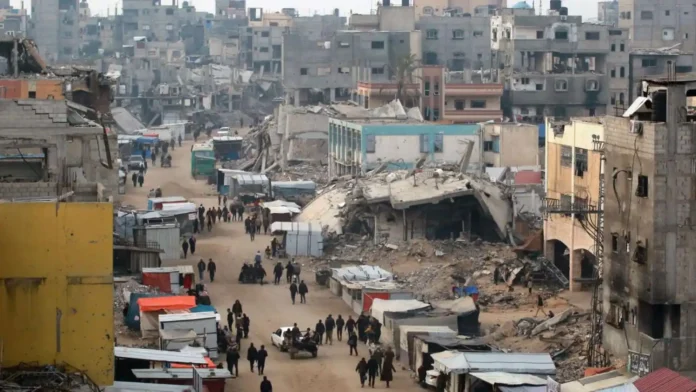Israel launched a wave of heavy strikes on Gaza, including bombings in Gaza City and southern areas like Rafah, hours after a ceasefire deal was announced.
The attacks left at least 32 people dead and continued into the early hours of Thursday, as authorities in Gaza and international mediators rushed to finalize the terms of the ceasefire, scheduled to begin on January 19.
The complex agreement, negotiated over months by Qatar, Egypt, and the United States, offers a six-week truce and a gradual withdrawal of Israeli forces from Gaza, a region devastated by 15 months of intense conflict.
The ceasefire also includes the release of hostages held by Hamas in exchange for Palestinian prisoners held by Israel. However, despite the announcement, Israel’s military escalated its bombardment of Gaza, raising fears that the truce might not hold.
On Wednesday, following the announcement of the ceasefire, which was greeted with both relief and caution in Gaza, celebrations erupted on the streets.
In Khan Younis, displaced families, struggling with shortages of food and fuel, danced in the streets and waved Palestinian flags in a moment of joy after enduring months of devastation.
One mother, Ghada, expressed her happiness through tears, saying, “I am happy. Yes, I am crying, but those are tears of joy.”
In contrast, the families of Israeli hostages welcomed the news in Tel Aviv, expressing “overwhelming joy and relief” at the possibility of their loved ones returning home after prolonged captivity.
The ceasefire deal is seen as a crucial step in de-escalating the violence in Gaza, which has killed over 46,000 people, mostly Palestinians, and displaced millions of others.
The agreement also aims to address the dire humanitarian crisis, with international organizations like the UN and the International Committee of the Red Cross preparing to scale up aid efforts.
US President Joe Biden praised the deal, highlighting its potential to bring much-needed humanitarian assistance to Gaza and reunite families torn apart by the conflict.
However, Israeli officials have raised concerns, with some hardliners in Prime Minister Benjamin Netanyahu’s coalition government opposing the truce.
Under the terms of the agreement, phase one will focus on the release of 33 Israeli hostages, including women, children, and men over 50, with two American hostages, Keith Siegel and Sagui Dekel-Chen, included in the first wave of releases.
Negotiations are set to continue, with the second phase planned for implementation on January 16, which is expected to include the release of all remaining hostages and the complete withdrawal of Israeli forces.
Despite international optimism about the agreement’s potential to end hostilities, the situation remains precarious.
Palestinian authorities and residents fear that Israel may intensify its military actions in the days leading up to the ceasefire, aiming to maximize military gains before the truce takes effect.
As the world watches, the path to peace remains uncertain, with both sides still grappling with the complex realities of post-conflict Gaza.
The international community, including Egypt, Turkey, and the United Nations, has welcomed the ceasefire as a potential turning point for the region, but with many key questions still unanswered, especially concerning Gaza’s future governance and reconstruction.

